Care instructions
MACHINE WASHING
Always check the care label before laundering, and separate linens into light and dark colors.
- Always pre-wash linens before first use.
- Wash light and dark colors separately.
- Machine wash on gentle cycle. For bed linens, use warm or cold water. For table and bath linens, use hot water for whites and cold water for colors.
- Use a mild liquid detergent without added bleach, whiteners, or fabric softeners.
- Pre-treat any stains prior to washing. Do not use bleach. Bleaching may weaken fibers and cause yellowing.
- Avoid laundering fine linens and bath towels with other items, especially those containing polyester, and items made of heavy material, rivets, buttons, zippers, and other hardware (for example, denim jeans) as these can damage fibers and fabric.
- Delicate lace and embellished linens should be placed in a pillowcase or a mesh laundry bag before being placed in the washing machine.
- Unless linens are very soiled, you need only use half the recommended amount of detergent.
- Do not overload the washing machine, as this can cause unnecessary abrasion to the fabric.
- Use of a fabric softener (liquid or dryer sheets) is not recommended for any fine linens, as it coats and weakens natural fibers. Your luxury linens will soften naturally with frequent use and additional washings.
- We recommend using three sets of bed linens in rotation: one on the bed, one in the wash, one in the linen closet. This will allow each set a rest from use and a rest from wash. Similarly, we recommend that you wash matching linens (e.g. sheets and pillowcases) together, as each piece should be cared for similarly to help maintain color consistency and brightness.
Hand Washing
- If the label says “hand launder,” never machine wash. Hand wash in gentle soap. Rinse thoroughly in clean water to eliminate all soap residue, then line dry, lay flat (on towels), or hang to dry. Avoid wringing linens by blotting on towels before air-drying.
Professional Cleaning
- Professional hand washing is recommended for delicate linens—those with heavy embellishments or embroideries, heirlooms, or worn linens. Be sure to use a reputable launderer who knows how to launder delicate linens.
Dry Cleaning
- We do not recommend dry cleaning for our natural cotton and linen products. Dry cleaning is recommended for luxury fibers such as cashmere, merino wool, and alpaca. Dry cleaning helps avoid excessive shrinkage on formal top-of-bed items such as matelassé blanket covers. Be sure to use a professional dry cleaner with experience in natural fibers and luxury linens.
DRYING AND IRONING
Drying
Line drying linens in soft, outdoor sunlight is ideal—it is the gentlest method of drying, and the sun provides natural bleaching—though this is not always practical.
- To machine dry bed and table linens, gently shake out and smooth damp linens before placing in the dryer (unraveling any items that may have twisted in the wash cycle). Do not use dryer sheet fabric softeners.
- Tumble dry be and table linens on low heat until slightly damp. Tumble dry bath towels on low to medium heat until dry.
- Avoid overloading the dryer so items will dry evenly.
- Set to the lowest heat—high heat settings will weaken the fibers and increase shrinkage.
- Remove items from dryer promptly and while still slightly damp. Smooth and let air dry before storing, or press with an iron while damp to remove any remaining wrinkles.
Ironing
Always check to make sure your steam iron is clean—mineral deposits may build up and cause brown spotting.
- Iron bed and bath linens while still slightly damp. Do not iron bath towels.
- Use a steam iron on a warm/hot setting for cotton or a hot setting for linen.
- Spray with water from a spray bottle for stubborn wrinkles, if needed.
- To restore the lustrous face of sateen and jacquard fabrics, iron on the reverse side.
- To preserve the three-dimensional effect of embroidery, iron on its reverse side, atop a white towel to give soft support to the thread work design.
- Linens with delicate lace and cut work should be ironed beneath a press cloth.




